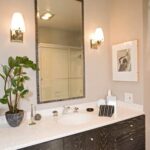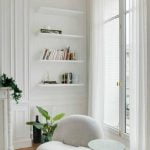Bringing a newborn baby into the world is an extraordinary experience that fills our lives with joy, excitement, and unconditional love. As soon-to-be parents, we eagerly anticipate the arrival of our little bundle of joy and want nothing but the best for them. One way to express this love and make their arrival even more special is by decorating our home in preparation for their welcome.
Decorating the home for a newborn baby’s arrival is not just about creating a visually appealing space; it is about creating a sanctuary that nurtures and comforts them in their early days. It is about setting up a space that promotes their growth, development, and overall well-being. From planning the nursery to choosing the perfect crib, every aspect of designing your baby’s space requires careful consideration and thoughtfulness.
A beautifully decorated nursery helps create a soothing environment for both baby and parent alike. The colors, themes, furniture choices, and even lighting can contribute to the overall ambiance of the room. It allows you to infuse your personal touch into the space while prioritizing safety and functionality. So let’s embark on this journey together as we explore different ways to decorate your home for your precious newborn baby’s welcome.
Planning the Nursery
Designing a nursery is an exciting and important step in preparing for the arrival of a newborn baby. The nursery should be a tranquil and functional space that fosters the baby’s growth and development while providing comfort and convenience for parents. When planning the nursery, there are several factors to consider, such as choosing a suitable room, selecting a color scheme and theme, and finding essential furniture and storage options.
Firstly, it is crucial to choose a suitable room for the nursery. Ideally, select a room that is close to the main living area of the house to ensure easy access during nighttime feedings or diaper changes. Consider factors such as natural light, ventilation, and proximity to other family members’ bedrooms. This will help create an environment that promotes a sense of security and closeness for both parents and baby.
Next, carefully consider the color scheme and theme for the nursery. Soft pastel colors like soothing blues, gentle pinks, or muted yellows are often preferred as they create a serene atmosphere. Additionally, opt for themes that are calming and stimulate imagination without being overstimulating. Popular choices include nature-inspired themes like animals or flowers or simple patterns like polka dots or stripes.
When it comes to furniture selection, focus on essential items that provide comfort, safety, and functionality. A crib is undoubtedly one of the most important pieces of furniture in the nursery. Ensure it meets safety standards with proper spacing between slats and no drop sides. In terms of storage options, invest in sturdy dressers or shelves to keep all baby essentials organized. Consider incorporating multifunctional furniture like cribs with built-in changing tables or glider chairs with ottomans.
To further enhance the calming ambiance of the nursery, add elements such as blackout curtains to block out light during naptime or bedtime routines. Choose rugs that provide padding on hard floors while adding warmth and texture to the room. When selecting bedding, prioritize materials that are soft, hypoallergenic, and easy to clean.
Designing the Perfect Crib
Creating a safe and comfortable sleep environment for your newborn baby is crucial for their well-being and development. The crib is the centerpiece of the nursery, and careful consideration should be given to its design and setup. In this section, we will discuss the importance of a safe and cozy crib, guidelines for choosing the right crib, mattress, and bedding, as well as tips on arranging the crib to create a soothing sleep environment.
The Importance of a Safe and Cozy Crib
Safety should be the top priority when selecting a crib for your newborn baby. Look for cribs that meet current safety standards, such as having slats that are no more than 2 3/8 inches apart to prevent your baby from getting stuck. Avoid cribs with drop sides or decorative cutouts that can pose hazards to your baby.
A cozy crib is essential for promoting quality sleep. Choose a mattress that fits snugly inside the crib without any gaps around the edges. Opt for firm mattresses over soft ones as they reduce the risk of suffocation or Sudden Infant Death Syndrome (SIDS). Additionally, ensure that all bedding in the crib is fitted tightly to prevent suffocation hazards.
Guidelines for Choosing the Right Crib, Mattress, and Bedding
When selecting a crib, consider factors such as durability, adjustability (to accommodate your growing baby), and ease of assembly. Convertible cribs are popular choices as they can be transformed into toddler beds or daybeds as your child grows.
Choose a mattress made specifically for infants and certified by safety standards organizations. Look out for labels stating conformity to safety regulations like ASTM International or Juvenile Products Manufacturers Association (JPMA).
For bedding, opt for fitted sheets that securely cover the mattress without any loose fabric or excess material that could pose suffocation hazards. Avoid using blankets, pillows, or any soft objects in the crib, as they increase the risk of SIDS.
Tips on Arranging the Crib and Creating a Soothing Sleep Environment
To create a soothing sleep environment, place the crib away from windows or any cords that babies can reach. This ensures your baby’s safety and reduces distractions during sleep time.
Consider adding blackout curtains or blinds to block out excess light. Babies sleep better when their room is dark and free from distractions.
You can also hang a mobile above the crib to entertain and soothe your baby. Choose one with contrasting colors or soft music to stimulate their senses gently.
Ensure that the temperature in the nursery is comfortable for your baby by utilizing a thermometer or thermostat. Keeping the room between 68-72 degrees Fahrenheit helps promote a restful sleep environment for newborns.
By designing a safe and cozy crib for your little one, you are establishing healthy sleep habits right from the start. Remember to regularly check and adjust the crib as your baby grows to ensure their safety and comfort throughout their early years.
Decorating the Walls
Decorating the walls of your baby’s nursery is an essential step in creating a personalized and welcoming space. The walls provide a blank canvas for you to add unique touches that reflect your style and create a soothing environment for your little one. Here are some ideas on how to add personalized touches to the nursery walls.
Decals, Murals, or Wallpaper
One popular way to decorate nursery walls is by using decals, murals, or wallpaper. Decals are easy to apply and remove, making them perfect for those who want to switch up the design as their baby grows. A mural can be a beautiful statement piece that adds depth and visual interest to the room. If you prefer a more permanent option, consider wallpaper with delicate patterns or playful motifs that match the nursery theme.
Personalized Elements
Adding personalized elements to the nursery walls can make the space even more special. One idea is to incorporate your baby’s name into the wall decor using wooden letters or custom vinyl lettering. You can also create a family photo gallery by framing photos of loved ones or displaying ultrasound images in a creative way. These personal touches will not only make the room feel unique but also provide meaningful memories for you and your child.
Balancing Aesthetics
When arranging wall displays in the nursery, it’s essential to find a balance between aesthetics and functionality. Consider placing larger items or focal points at eye level where they can capture attention without overwhelming the space. Create visual cohesion by keeping colors and styles consistent throughout the room.
Remember that less can be more when it comes to wall decor, so avoid cluttering the walls with too many items. This will help maintain a calm and serene atmosphere that promotes relaxation for both you and your baby.
By taking these tips into consideration, you can transform your baby’s nursery into a personalized haven filled with warmth and love. The walls will not only serve as a backdrop but also as meaningful reminders of your journey into parenthood. Get creative, experiment with different ideas, and have fun making this space uniquely yours.
Soft Furnishings and Textiles
Soft furnishings and textiles play a crucial role in creating a cozy and warm atmosphere in your newborn baby’s nursery. These elements not only enhance the overall aesthetics of the room but also contribute to the baby’s comfort and well-being. Here are some tips for selecting the right soft furnishings and textiles for your baby’s nursery:
- Curtains: Choose curtains that are made of soft, breathable fabric to regulate the temperature and allow natural light into the room. Opt for blackout curtains or blinds to create a dark environment that promotes uninterrupted sleep during daytime naps.
- Rugs: Consider adding a plush rug to provide warmth underfoot and add an extra layer of comfort to the nursery. Look for rugs that are hypoallergenic and easy to clean, as they will undoubtedly be exposed to spills or accidents.
- Bedding: Use soft, organic cotton sheets for your baby’s crib or bassinet. Ensure that the bedding fits properly and is free from any loose or excess fabric that could pose a suffocation risk.
- Pillows and Blankets: While it is advised not to place pillows or loose blankets in an infant’s crib due to safety concerns, you can incorporate them into other areas of the nursery such as rocking chairs or nursing corners. Opt for soft fabrics with gentle patterns or textures that add visual interest without overwhelming the space.
When selecting fabrics for your baby’s nursery, prioritize those that are safe, durable, and easy to clean. Avoid using materials like wool or rough fabrics that may cause skin irritation on your little one’s sensitive skin. Additionally, consider eco-friendly options such as organic cotton or bamboo fabrics which are free from harmful chemicals.
Remember that creating a cozy and warm atmosphere goes beyond just selecting these soft furnishings and textiles-it also involves maintaining proper temperature control in the room using thermostat controls or fans when needed. With these considerations in mind, you can ensure that your newborn baby will feel comfortable, safe, and surrounded by warmth in their nursery.
Organizing and Storage Solutions
In order to keep the nursery clutter-free and organized, it is important to have efficient organizing and storage solutions in place. A tidy and well-organized nursery not only creates a visually pleasing space but also makes it easier for parents to navigate daily routines with their newborn baby.
One effective solution for organizing the nursery is the use of baskets and bins. These can be used to store small items such as socks, bibs, or toys. Consider using labeled baskets or clear bins so that you can easily locate items when needed. Hanging organizers are also useful for storing diapers, wipes, and other essential supplies within reach.
Shelves are another great option for keeping the nursery tidy. Install wall shelves above the changing table or near the crib to display items such as books, stuffed animals, or decorative pieces. This not only adds a touch of personalization but also helps free up floor space. Utilize floating shelves or bookshelves with compartments for added versatility.
When it comes to clothing storage, consider investing in a dresser or chest of drawers with ample drawer space. Label each drawer according to different clothing categories like onesies, pajamas, or accessories. This will make it easier for you to find specific items when dressing your baby.
Lastly, don’t forget about utilizing vertical space in the nursery. Adding hooks on the walls can be a convenient way to hang items like blankets, hats, or towels. You can also install an over-the-door organizer on the back of the nursery door to store shoes or extra clothes.
By incorporating these organizing and storage solutions into your nursery design, you will create a clutter-free and functional space for your newborn baby’s daily needs. Remember to regularly declutter and reorganize as your baby grows to maintain an organized nursery environment that suits your evolving needs.
Lighting Considerations
Proper lighting is essential when designing a nursery for your newborn baby. The right lighting can create a warm and soothing ambiance that promotes relaxation and sleep. In this section, we will discuss the significance of lighting considerations and provide tips on how to introduce soft illumination in your baby’s nursery.
When it comes to lighting, it’s important to prioritize safety. Avoid using harsh or bright lights that may disturb your baby’s sleep. Instead, opt for soft, diffused lighting that mimics natural light. Consider installing dimmable lights so you can adjust the brightness according to your baby’s needs at different times of the day.
Nightlights are also a great option for nurseries as they provide a gentle glow during nighttime feedings or diaper changes without fully waking up your baby. Look for nightlights with adjustable brightness settings and consider ones that project soothing images or play lullabies to help promote relaxation.
In addition to functional lighting, you can also incorporate decorative elements to enhance the overall aesthetic of the nursery. Consider adding fairy lights or string lights around the room for a magical touch. You can hang them along the walls, above the crib, or even on shelves to create a warm and cozy atmosphere.
Remember, when selecting light fixtures or lamps for your baby’s nursery, ensure they are securely installed and out of reach from curious little hands. Also, be mindful of cords and opt for cordless options where possible or make sure cords are safely secured and away from areas accessible by children.
By considering these lighting considerations, you can create an inviting and calming space for both you and your newborn baby to enjoy together.
Adding Personal Touches
When it comes to decorating a nursery for a newborn baby, adding personal touches can truly make the space feel unique and special. DIY projects and custom decorations allow parents to create a one-of-a-kind environment that reflects their own style and taste.
Not only does this add character to the nursery, but it also creates sentimental value for both the parents and the child. Here are some ideas for adding personal touches through DIY projects and custom decorations:
- Handmade Mobiles: Create a beautiful mobile using various materials such as paper, fabric, or felt. You can choose to incorporate shapes or objects that hold meaning for you and your family.
- Artwork: Design and create your own artwork to hang on the walls of the nursery. Use paint, stencils, or even handprints or footprints to make personalized pieces of art.
- Customized Growth Chart: Make a growth chart that not only tracks your baby’s height but also adds a decorative element to the room. Paint or stencil your child’s name on it for an extra personalized touch.
- Memory Collage: Gather photographs, mementos, and other cherished items from your baby’s first year and create a collage or shadow box display. This will serve as a beautiful reminder of all the wonderful memories.
- Personalized Name Sign: Use wooden letters or fabric banners to spell out your baby’s name and hang it on their bedroom door or above their crib. There are many creative ways to personalize these signs, such as using different colors, patterns, or textures.
- Homemade Wall Decals: Cut out shapes or designs from adhesive vinyl sheets to create your own wall decals. This allows you to customize the nursery with specific designs or patterns that resonate with you.
Adding these personal touches not only adds sentimental value but also creates a unique environment that your newborn will grow up in. It’s important to remember to prioritize safety when creating DIY projects or custom decorations for the nursery. Avoid using small or sharp objects that could be a choking hazard, and always ensure that any materials used are non-toxic and baby-friendly.
By embracing your creativity and incorporating DIY projects and custom decorations into the nursery design, you can create an inviting and personalized space for your newborn baby. These personal touches will not only make the room feel special but also become cherished memories of their first years.
Conclusion
In conclusion, welcoming a newborn baby into your home is a truly special and joyous occasion. By planning the nursery, designing the perfect crib, decorating the walls, choosing soft furnishings and textiles, organizing and implementing storage solutions, considering lighting options, and adding personal touches, you can create a welcoming sanctuary for your little one.
Throughout this article, we have emphasized the importance of creating a safe and nurturing environment for your baby. From selecting the right room for the nursery to arranging the crib in a soothing manner, each step has been focused on ensuring that your baby feels comfortable and secure in their sleep environment. Additionally, we have provided suggestions for personalizing the nursery with wall decor, soft furnishings, and custom decorations to add a unique touch to this special space.
Remember that every decision you make while decorating should prioritize your baby’s safety and comfort. Choose furniture and textiles that are easy to clean and hypoallergenic. Consider incorporating dimmable lights or nightlights to provide soft illumination during nighttime tasks without disturbing your baby’s sleep.
In embarking on this journey of preparing a welcoming sanctuary for your newborn baby, remember to embrace your creativity and enjoy the process of decorating. This is not only an opportunity to create a beautiful space but also to bond with your little one even before they arrive. Cherish these moments as you eagerly anticipate their arrival and know that you are creating a warm and loving environment where they will thrive. Congratulations on this exciting new chapter.
Frequently Asked Questions
How do I decorate my home for a newborn welcome?
When it comes to decorating your home for a newborn welcome, it’s important to create a warm and soothing environment that is both practical and visually appealing. Start by selecting a color scheme that promotes tranquility, such as soft pastels or neutrals. Consider adding elements like wall decals with gentle patterns or cute animal motifs to create a playful atmosphere.
Invest in comfortable furniture such as a rocking chair or glider for those late-night feedings and cuddles. It’s also essential to focus on safety by baby-proofing the space, ensuring that cords are out of reach and any sharp edges are covered. Finally, add personal touches like framed pictures or a letterboard with the baby’s name to make the space feel even more special.
How do you welcome a newborn to the house?
Welcoming a newborn into your home is an exciting time that requires careful preparation and thoughtfulness. First and foremost, create a calm environment by keeping noise levels low and maintaining a comfortable temperature in the house. Greet both parents and baby with warmth and congratulations upon their arrival, making them feel at ease in their new surroundings.
Gentle gestures such as offering assistance with carrying bags or providing refreshments can go a long way in making the family feel supported during this transition period. To help them settle in smoothly, ensure that the nursery is set up and ready for use, including essentials like diapers, clean bedding, and basic toiletries.
How to decorate a room for new born baby?
Decorating a room for a newborn involves considering both aesthetic choices as well as practicality for the child’s needs. Start by planning the layout of furniture so that it accommodates all necessary items while leaving enough space for movement. Choose colors that promote serenity and stimulation; pastel shades are often favored due to their calming effect on babies’ eyesight. Add soft lighting options such as dimmable lamps or fairy lights to create an inviting ambiance during nighttime activities.
Include storage solutions like shelves or bins to organize clothes, toys, and other essentials. Be mindful of safety and hygiene by installing window locks, covering electrical outlets, and using washable materials for bedding and curtains. Additionally, consider incorporating elements like mobiles or wall art that stimulate the baby’s senses and imagination in a developmentally appropriate manner.

I’m thrilled to be your companion on this exciting journey through the world of home decor and design. With a passion for turning houses into homes and a keen eye for the finer details, I’m here to help you transform your living spaces into beautiful, functional, and meaningful havens.





